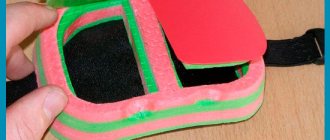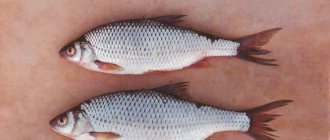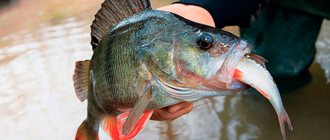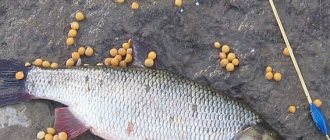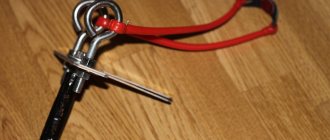Why do you need a bloodworm?
The bloodworm, first of all, will help preserve the bait, especially in conditions when it is frosty outside, especially since you have to travel far for fishing. It will be a great pity, and fishing simply will not take place if the bloodworms turn into larvae unattractive to fish. If it freezes and immobilizes, then it will no longer attract fish. In this case, the fish will only be interested in live bait, and only in this case can you count on a catch.
In this regard, certain requirements are imposed on the bloodworm. For example:
- The moth bottle must be made of durable material. Very often, fishermen place bloodworms in matchboxes, which cannot withstand loads, especially unexpected ones, and the bait becomes unusable. In addition, in the process of moving such a matchbox can simply get lost.
- The lid in such a homemade product must fit tightly to the base of the box, otherwise the bloodworm may fall out of it or crawl out: after all, it is alive.
- The device must provide proper thermal conditions with air access, otherwise the larvae will either freeze or die.
Making moth bottles with your own hands
Mothworm
Fishermen make most of the devices with their own hands, and the bloodworm is no exception. The thing is that the amount of fishing equipment that is really necessary for fishing is simply not realistic to buy for money. This is despite the fact that some of them don't cost a lot of money. But if you add up all the funds, you get a solid figure.
This is a very simple device in design, which is made from scrap materials. Of course, anyone who doesn’t want to waste precious time on this process can go to a fishing store to buy such a simple device.
What you need
It is very important that the blood cell has the ability to maintain temperature conditions. Alternatively, this can be organized by placing this device on the fisherman’s knee. The strength of the moth can be ensured if it is made of polystyrene foam. Moreover, only dense foam plastic is suitable. Such foam will not only be durable, but will also be able to retain heat inside the device. To ensure that the heat from the fisherman’s foot easily penetrates inside the moth, its lower part is made of summer, non-dense fabric. The material from which thermal mats are made is also suitable for the manufacture of the case. This material is not expensive and a device of any shape can be made from it, as it is easy to process.
How to make a moth bottle from foam plastic?
Polystyrene foam is an inexpensive but practical material that is easy to process and retains heat well. Therefore, it is quite possible to make a moth bottle from polystyrene foam in the form of a small box. It should be recalled that only dense foam plastic, for example, the one used to make floats, is suitable. Although many fishermen make do with ordinary polystyrene foam, but with a higher density.
What is needed for this:
- Styrofoam.
- Steel wire.
And also tools:
- Hacksaw.
- Stationery knife.
- Sandpaper (zero grade).
Large mothbox with your own hands. 11th issue
How to do it:
- Taking a piece of polystyrene foam, the dimensions of the future box (mothbox) are marked on it. The box may differ in the following dimensions: 8 by 5 by 3 centimeters.
- The workpiece is cut out along the lines of the applied pattern using a hacksaw. It is better to use a hacksaw, as it has very fine teeth.
- Stepping back 5 mm from the edges of the cut-out workpiece, you should draw another rectangle, which will later turn out to be the inside of the bloodworm, where the larvae will be stored.
- The inner part is cut out using a stationery knife. It should be pulled out so that it does not reach the bottom of the workpiece by 5 mm.
- After this, you can begin making the lid for this box. Its dimensions: 7 by 4 by 5 centimeters.
- After manufacturing, the cap is tightly adjusted to the hole using sandpaper.
- The lid and the box are connected using a wire 1 mm thick.
- To do this, a hole is drilled in the back of the box and lid. It is better to drill the box together with the lid so that the holes match exactly.
- After drilling the hole, you can begin to connect the box and lid. To do this, insert the lid into the box and insert the wire into the hole.
- If something prevents you from making a connection, then it is better to treat suspicious areas with sandpaper.
To protect the bait from the cold, you can put a piece of flannel on the bottom of such a bloodworm.
Creation of one - and three-section knee bloodworm
To create such a homemade product you will need some materials and tools. In this case, there are no special requirements for materials, therefore, each angler using this model will be able to make a device from any suitable material. The main thing is that the product performs its main functions.
You will need the following materials:
- Glue.
- Thin material.
- Thermal saving material.
- Karemat.
- Plastic for gaskets.
You will also need the following tools:
- Stationery knife.
- Scissors.
Do-it-yourself knee moth. 15th edition.
Manufacturing stages
Before starting production, you should carefully consider all the stages of production, and also decide on the shape and size of the future bloodworm. The advantage of making it yourself is that you have the opportunity to do exactly what is needed. It is not possible to buy what you need in a store. This is another factor that forces fishermen to make their own gear. Options for the most common homemade products will be discussed in this article.
Making a simple bloodworm
- At the initial stage, three rectangles should be formed from heat-resistant material.
- “Windows” of the required size are formed in the center of these rectangles. The thickness of the walls of the future moth chamber should be about 10 mm.
- The fabric is attached to the bottom, and then the elastic band is attached with glue.
- Some anglers make the mistake of not securing the elastic between two layers of fabric, which prevents heat from flowing inside the box. Due to the elastic band, reliable contact of the bloodworm with the fisherman’s body is ensured.
Now all that remains is to test this device on winter fishing, in the midst of real cold. As a rule, fishermen keep bloodworms in their bosoms, which is very inconvenient. Every time you have to reach into your bosom in search of bait. What to do if the bite is quite intense? If you make a moth like this and attach it to your knee, then fishing will be not only exciting, but also enjoyable: after all, the bait will always be at hand.
There is another homemade product designed for three compartments. The bloodworm for bait is stored in one compartment, the feed bloodworm is stored in the second compartment, and the third compartment is used for jigs and maggots. Sometimes this approach works.
Moth tray with several compartments
To make such a box, you will have to follow these steps:
- Small blanks are created, measuring 150 by 170 mm from karemat.
- The lower layers, and there should be three of them, are carefully glued together with glue.
- After this, small “windows” are formed in the blanks.
- After this, the fourth layer of karemat is glued.
- Next, the homemade products must be carefully cultivated using fine sandpaper.
- Finally, rubber bands are attached to the homemade products, which serve to secure the bloodworms to the leg and to secure the lids.
- But that’s not all, you should secure the linings to the lid, after which the bottom layer of fabric is glued. The bloodworm for winter fishing is ready and all that remains is to cultivate the product a little and then try it out on fishing.
DIY sports moth
DIY photo of a bloodworm
Note!
How to minimize fishing costs? Useful tips from experienced fishermen and an overview of current solutions (65 photos)Do-it-yourself boat motor - tips for beginners, projects, drawings and step-by-step description of the construction of the main components and elements (video + 120 photos)
Feeder for winter fishing - secrets of use and techniques for feeding fish in winter (115 photos)
Read here DIY anchor: drawings, sketches, diagrams, photos and videos describing the construction of simple and effective homemade anchors
Help the project, share on social networks
0
What should you pay attention to when making
Even such a simple production of simple boxes requires certain rules. For example:
- There is no need to apply glue over the entire surface of each layer. It is enough to apply it where the walls of the entire structure are located. In this case, a considerable amount of glue is saved.
- To form a compartment in a 3-layer workpiece, it is better to use a stationery knife with a narrow blade. If there is no such knife, but there is a knife with a wider blade, then the blade can be narrowed using pliers.
- To give all layers a certain shape, you should use an auxiliary form. A tin can or other unnecessary container is suitable for this.
- When forming the windows of the fourth layer, the knife should be held at an angle, towards the center of the product. The result is a window with a slope towards the center. This will make it possible to hold the lid in a fixed position without special clamps.
- After completing the final operations, the product is sufficiently processed to remove burrs or sharp edges.
- The elastic bands on the leg should be connected with Velcro, which will prevent snow from getting into the moth.
- The presence of special linings on the covers of homemade products makes them somewhat stronger. In addition, special linings will allow you to open the crankcase without much effort, and they also close the gap where unnecessary cold can penetrate.
- The material for the plastic pads must be dense. Plastic from ordinary plastic bottles will not work.
- The fabric for the bottom layer should be thin, otherwise it will not transmit heat inside the mothbox. On the other hand, it must have a special impregnation so that the juice that the bait secretes does not get on clothes, as stains may form.
What to pay attention to when making
In addition, such simple production of simple boxes requires certain rules. Eg:
- There is no need to apply glue over the entire surface of each layer. It is enough to apply it where the walls of the entire structure are located. Under such conditions, a large amount of glue is saved.
- In order to form a compartment in a 3-layer workpiece, it is better to use a stationery knife with a narrow blade. If there is no knife, but there is a knife with a wider blade, then the blade can be narrowed using pliers.
- To give all layers a certain shape, use an auxiliary form. A tin can or other unnecessary container is suitable for this.
- When forming windows of the fourth layer, keep the knife at an angle, towards the center of the product. The result will be a window with a slope towards the center. This will allow you to hold the lid in a fixed position without special latches.
- Upon completion of the final operations, it is enough to process the product in order to remove burrs or sharp edges.
- The elastic bands on the leg should be connected using Velcro, which will prevent snow from getting into the moth.
- The presence of special linings on the lids of homemade products makes their pair stronger. Also, special linings will allow you to open the butterfly without much effort, and in addition, they close the gap where unnecessary frost can penetrate.
- The material for the plastic pads must be dense. Plastic from ordinary plastic bottles will not be shipped.
- The fabric for the bottom layer should be narrow, otherwise it will not transmit heat inside the mothbox. Otherwise, it must have a special impregnation so that the juice that the bait secretes does not get on the clothes, as stains may appear.
